Heritage Register
Jubilee
1900 Fort Street
Royal Jubilee Hospital
Built
1889-2009
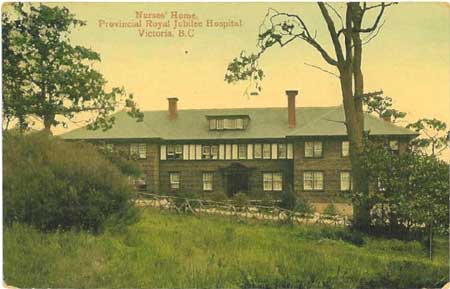
One day in 1858 a sick miner was dumped by his friends in the garden of the Christ Church cathedral rectory, with the men evidently believing that the Rev Edward Cridge could heal bodies as well as souls. This incident is quite well documented and it led to the founding of what would eventually become the Royal Jubilee Hospital.
Cridge wasted no time in organizing community support for a cottage hospital for men, in a small rented building at Yates and Broad Sts. This men’s infirmary later moved to the Songhees Reserve area in Victoria West, with a larger building named the Royal Infirmary.
Mrs Edward Cridge and Mrs Thomas Harris (wife of Victoria’s first mayor) were, at the same time, campaigning vigorously for a women’s infirmary. They were offered a ward at the Royal but held out for a new building. In 1864, the cornerstone of a substantial building was laid, at the head of Pandora Av where the First Church of Christ Scientist (1511 Chambers St, Fernwood) now stands.
Eight years later this women’s infirmary and the Royal Infirmary merged into one hospital in the Pandora building. This was quickly outgrown and Queen Victoria’s jubilee in 1887 became the incentive for a new, larger hospital to serve the rapidly growing city.
Twenty acres of land were purchased for $6,700 from the Finnerty family, who owned a large tract of market gardening and farm land. The new hospital grounds, at the corner of what was then Cadboro Bay (now Fort) and Mount Tolmie (now Richmond) Rds, were quite isolated from the city, with only five houses in the vicinity.
John Teague (North Park History) designed the first building on the hospital grounds, built by contractor Thomas Catterall (Teague’s description ran in the Victoria Daily Colonist of April 24, 1889). It was to accommodate 100 patients and the cost was estimated at $35,000, but ended up at $50,558. Elford (1119 Ormond St, Fernwood) & Smith (Hillside-Quadra History) were the contractors. The cornerstone was laid in April 1889 and a time capsule beneath it contained a plan of the building, some silver currency and an English sovereign. H.R.H. the Duke of Connaught (Queen Victoria’s son) officiated at the opening ceremonies on 21 May 1890 and the new hospital was named the Provincial Royal Jubilee Hospital. It was demolished in 1962, and replaced with a new wing.
There were three wards (male surgical, medical and women’s), an administration block with accommodation for a resident medical officer and a matron, a laboratory, an “accident” ward, a meeting room, a kitchen and storerooms. There was no sewer system in the area at that time and it was another six years before electricity was installed. A school of nursing opened in December 1891 and it trained nurses for over 90 years.
An early photograph shows an imposing stone entrance at the corner of what is now Fort St and Richmond Rd. A picket fence measuring almost a mile surrounded the grounds and was constructed by W.H. (Bill) Handley, who later joined the city police force and eventually became Oak Bay’s first chief of police.
In 1896 the Pemberton Memorial Operating Theatre was built to designs by John Teague and was used until 1925 when the East Wing opened. This wing was designed by P.L. James and K.B. Spurgin and included six operating rooms. The East Wing still stands in 2009. The Pemberton Memorial Chapel by architect J.C.M. Keith was built in 1909.
The Strathcona Ward was added in 1904 and the first children’s ward in 1906, by architects Hooper & Watkins. A first nurses’ residence opened in 1909 and was replaced by Begbie Hall in 1930, designed by C. Elwood Watkins .
Other early additions were a TB ward in 1910 and the first maternity ward in 1916. By the end of the 1930s the complex of buildings was re-named the Royal Jubilee Hospital. Further additions included a major new wing in 1940 designed by C. Elwood Watkins, a maternity wing in 1946 designed by provincial architect Henry Whittaker and built with financial assistance from the Kiwanis Club of Victoria, and conversion of the 1904 Strathcona Ward to a children’s ward in 1948. The latter two were to meet the demands of the post-WWII “baby boom.”
In 1947, the present Memorial Pavilion was constructed as the Department of Veterans Affairs Hospital, designed by architects Mercer & Mercer, constructed by Northern Construction Co and J.W. Stewart Contractors. The present Adanac Services building was designed for the Canadian Red Cross by W.F. Gardiner and built in 1946-47. Both buildings are in Saanich and are registered heritage by that municipality.
Construction following a $105-million expansion plan developed in the mid-1990s was still in progress at time of writing.
Royal Jubilee Hospital
Pemberton Memorial Operating Theatre
Built 1896
National Historic Site
Architect: John Teague
Contractor: Thomas Catterall
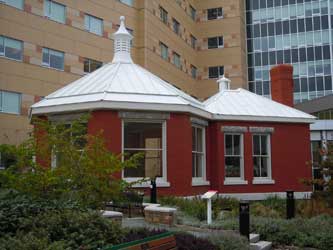
The estate of the Hon. Joseph Despard Pemberton, colonial Surveyor General, and his widow Teresa Jane Pemberton both donated funds to build a maternity wing at the hospital. However, the hospital directors concluded that the funds were not sufficient for that purpose, and this octagonal, red brick operating theatre was built instead.
The cornerstone was laid May 15, 1896; John Teague placed a copper box under the stone and Thomas Catterall plumbed the stone. Large windows dominate every wall to admit the maximum amount of daylight. An ornate metal lantern caps the building, and there is evidence of an original entry porch. The floor plan allowed for efficiency, with the patient placed in the centre of the room. The unusual building is dramatically different from the mainstream work of this prolific architect, who is best known for his large, Italianate public buildings (City Hall, Masonic Temple). The operating theatre continued in daily use until 1925, when the East Wing of the Hospital opened.
A school of nursing opened in 1891 but that left the hospital with a $15,000 debt. As well, a smallpox outbreak in 1892 meant that an isolation unit was more urgently needed than an operating theatre. The financial situation was eased by a $2,000 bequest from the Pemberton estate. Dr John Helmcken (638 Elliot St, James Bay) wanted it used for a maternity unit. However, the Pemberton bequest was not adequate for this purpose, even after Sophie Pemberton offered another $1,500 and told the hospital that the donation could be used for anything of benefit to the hospital.
Helmcken’s plan was opposed by Dr John Chapman Davie (638 Rockland Pl), who had come under the influence of the great Dr Joseph Lister, who promoted sterile surgery, while on a European sabbatical leave. Dr Davie wanted to bring antiseptic principles and practices to the Jubilee and eventually his proposal won out, as it was thought that a dedicated operating suite was essential to a modern hospital. Dr Helmcken promptly resigned from the hospital staff.
Thomas Catterall’s tender came to $3,614 and once again, Mrs Pemberton covered the slight deficit.
Dr Davie asked for an almost free-standing building in order to limit access to anyone but patients, doctors and nurses. Dr Lister came to Victoria in 1897 and was impressed with the new operating room, although he recommended adding a recovery room. Two post-op recovery rooms were quickly built and the complex was wired for electricity.
An X-ray machine was installed in 1899, only four years after this new technology became available. It was used until the East Wing of the hospital opened, with up-to-date facilities. The Pemberton Memorial Operating Theatre then became a cancer clinic and was later used to store medical records.
In 1982 the Victoria Medical Society requested heritage protection for the operating theatre, along with the Pemberton Memorial Chapel, as a major expansion of the hospital was planned. Designation was stalled by concerns about the cost of moving these two structures to make space for new buildings. Financial restraints in the later 1980s allowed a reprieve and a further heritage protection request from the Victoria Medical Society, in 1991, described the operating theatre as “the first surgical operating room on the west coast of North America, north of San Francisco.” Heritage designation was granted in 1994 and, by this time, the planners of the hospital expansion had decided that it would cost less to build the expansion around the chapel and the operating theatre, rather than move them (see below re: chapel).
The Victoria Medical Society is raising funds to restore the operating theatre and to create a public medical museum with archives, a library and meeting space. Total cost of the project is estimated at approximately $450,000.
When completed, the Pemberton will be the only restored operating theatre in Canada.
Royal Jubilee Hospital
Pemberton Memorial Chapel
Built 1909
Heritage-Designated/Institutional
Architect: J.C.M. Keith
Contractor: Parfitt Brothers
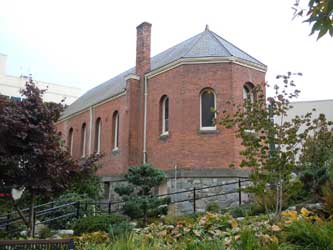
This charming little brick chapel is a far cry from the imposing Christ Church Cathedral that J.C.M. Keith designed two decades earlier. Teresa Jane Despard Pemberton, widow of Joseph Despard Pemberton, bequeathed the funds for this non-denominational chapel, dedicated on Dec 29, 1909. Her artist daughter Sophie (later Mrs Deane-Drummond) designed the interior decoration.
A bridge from the modern hospital building, which wraps around it, replaces the original granite entry stair. The roof, with its original slate, is hipped, with a gable on the east end, over a modest rose window. The nave is rectangular, while the apse is semi-octagonal. Heavy timbers spring from hand-painted brackets to support the roof. The interior walls are panelled in stained and varnished wainscotting, with matching pews and furnishings; the walls above the panelling are natural brick. The windows throughout are simple diamond lights in round arched openings. The Norman-style chancel arch and the west windows are emphasized with terracotta mouldings. A choir loft at the rear now houses an organ.
The chapel remained in use until the mid-1980s when it was deemed in need of restoration and was nearly lost to a major hospital expansion plan. However it received heritage protection and it was decided that it would cost less to re-design the expansion around the chapel and the operating theatre. In 2002 the RJH School of Nursing Alumnae Association joined with VIHA and the Greater Victoria Hospital Foundation to restore both the chapel and the operating room. The chapel restoration was estimated to cost $700,000. Access to the chapel from the new Diagnostics and Treatment Centre was included in the plan as well as space for archival storage and a nursing museum in the basement. The chapel re-opened in June 2003. It is open to the public, from the hospital’s second floor.
A memorial garden, dedicated to Dr Inazo Nitobe, is in the area between the chapel and the operating room. Dr Nitobe was at one time Under-Secretary of the League of Nations. A highly esteemed ambassador for world peace, he died at the Royal Jubilee Hospital in 1933, soon after attending an international conference in Banff, AB.
Royal Jubilee Hospital
Begbie Hall
Built 1929-30
Heritage-Designated/Institutional
National Historic Site 1997
Architect: C. Elwood Watkins
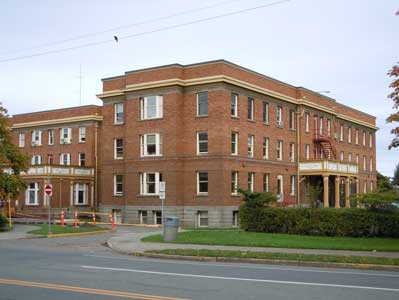
Mrs Mary Ann Tolmie, wife of Premier Simon Fraser Tolmie, opened the new nurses’ residence at Royal Jubilee Hospital in 1930. Replacing an earlier nurses’ residence, it cost almost $200,000, and was later named Begbie Hall, in honour of Chief Justice Sir Matthew Baillie Begbie. It provided learning facilities and accommodation for students of the Royal Jubilee School of Nursing. The basement housed classrooms, laboratories, a library and instructors’ offices, and the first floor provided accommodation for staff, a suite for the matron, and a reception room. The top two floors housed the nursing students. The interiors are substantially intact, most notably the recreation room, with beamed ceiling and fireplace, now called Woodward Hall. Begbie Hall served in this capacity until the Nursing School closed in 1983.
Architect Watkins continued the vocabulary of the East Wing, designed by Percy Leonard James and Karl Branwhite Spurgin (1921-25), demonstrating some of the Beaux-Arts Classical features of his Victoria High School (1910-14, 1260 Grant St, Fernwood). Based on a symmetrical H-pattern footprint, the flat-roofed building has porticoed entrances at each end, and a substantial central enclosed porch with faux pillars. The exterior is clad in brown brick, with elaborate patterns and recessed pointing. A variety of large cast relief panels decorate the street façades, linked by a belt course of decorative brickwork. The large windows have horns on the sashes –an unusually late use of this feature, generally discontinued before WWI. And many of the front windows are recessed and angled in a pattern popularized decades earlier by Thomas Hooper, Watkins’ mentor and former partner.
Begbie Hall was recognized by Canada in 1998 as one of five nurses’ residences “of national historic significance related to women.” They “spoke to the training and professionalism of nurses, to their social life, to the development of their unique culture and to the emergence of leaders in the field of nursing.” The building of Begbie Hall in 1930 can therefore be seen as a direct result of important changes in how nurses and their training were viewed. The professionalism that Florence Nightingale fought for was now a reality, with nursing attracting well-educated young women. In residences such as Begbie Hall, a combination of a “home-like” atmosphere and fairly strict supervision meant that parents could safely entrust their daughters to living and working away from home.
Begbie Hall was designated heritage by the City of Victoria in 2003. It now houses administrative offices and records, and Woodward Hall is used for meetings, conferences and social events.
Royal Jubilee Hospital
No. 10 Streetcar Shelter
Built 1910
Heritage-Registered/Institutional
For: British Columbia Electric Railway Co Ltd
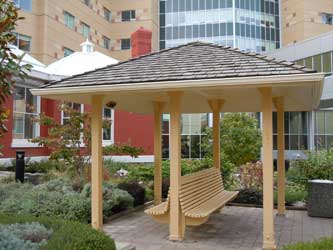
The Victoria and District streetcar system began service in 1890 with four cars and two lines. Victoria was one of only three Canadian cities to have streetcars at the time. The original company, National Electric Tramway & Lighting Co, was taken over by BC Electric Railway Co.
The No.10 Mt Tolmie line opened in 1910 with just two trips a day. The main purpose of the No.10 line was to take boys to the University School (now St. Michael’s University School) at 3400 Richmond Rd in the morning and bring them back downtown in the afternoon. However, as the line ran from Douglas St along Fort St to Richmond, terminating at Mayfair Dr, it also served staff and patients to and from the hospital. More trips were added as the city and the streetcar system both grew. The system was in service until 1947-48 when buses replaced streetcars.
This is one of only two remaining original shelters - the other is beside Camosun College. This one was outside the Saanich end of Royal Jubilee Hospital, and was listed on Saanich’s Heritage Register in 1990. In 2001 the shelter was moved to the south side of RJH’s main access road on the Victoria side, and was registered as a City of Victoria heritage site. The shelter continued in use for bus passengers until 2009, when moved again for storage to Saanich property while the new facility is being built.
The shelter has a pyramidal hipped roof with cedar shingles. The roof is supported by posts and brackets. A double-sided bench is slung between the two central posts of the shelter.
ADDITIONAL INFORMATION & IMAGES:
• Map of Victoria's Heritage Register Properties
• Jubilee History
• Jubilee Heritage Register
• This Old House, Victoria's Heritage Neighbourhoods,
Volume Four: Fairfield, Gonzales & Jubilee





